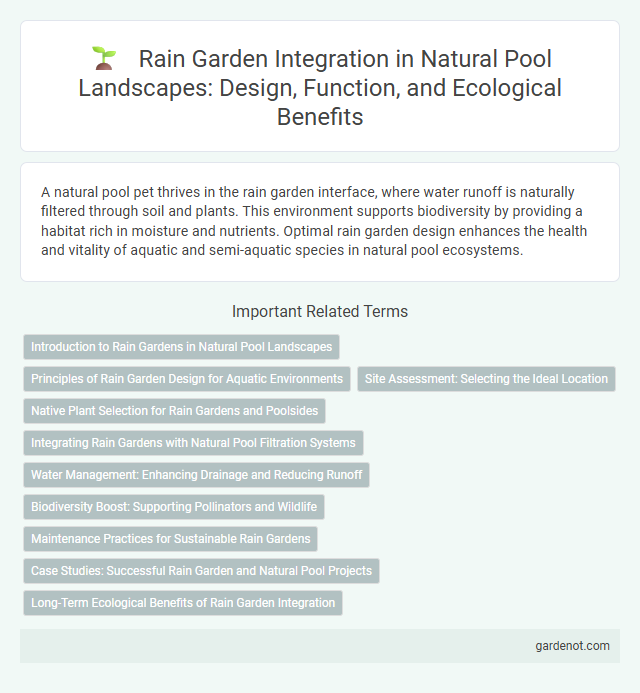A natural pool pet thrives in the rain garden interface, where water runoff is naturally filtered through soil and plants. This environment supports biodiversity by providing a habitat rich in moisture and nutrients. Optimal rain garden design enhances the health and vitality of aquatic and semi-aquatic species in natural pool ecosystems.
Introduction to Rain Gardens in Natural Pool Landscapes
Rain gardens in natural pool landscapes function as sustainable water management systems that capture and filter runoff, enhancing water quality while promoting biodiversity. These gardens use native plants with deep root systems to absorb excess rainwater, reduce erosion, and support natural filtration processes. Integrating rain gardens adjacent to natural pools creates an eco-friendly interface that balances aesthetics with environmental benefits.
Principles of Rain Garden Design for Aquatic Environments
Rain garden design for aquatic environments emphasizes soil permeability and native plant selection to maximize water infiltration and pollutant filtration. Strategic contouring and mulching control runoff velocity, reducing erosion and facilitating groundwater recharge. Incorporating a diverse mix of hydrophytic vegetation enhances habitat complexity while stabilizing the natural pool's edge and improving water quality.
Site Assessment: Selecting the Ideal Location
Site assessment for rain garden interface in natural pools involves analyzing soil permeability, slope gradient, and existing vegetation to ensure efficient water absorption and filtration. Selecting a location with well-drained soil and natural runoff paths optimizes stormwater capture while preventing erosion and waterlogging. Proximity to impervious surfaces and downspouts enhances the rain garden's ability to reduce pollutants entering the natural pool, maintaining ecosystem balance.
Native Plant Selection for Rain Gardens and Poolsides
Native plant selection for rain gardens and poolsides enhances natural water filtration and erosion control. Species such as Carex, Juncus, and Asclepias thrive in wet soils while supporting local biodiversity and requiring minimal maintenance. Integrating these native plants into poolside rain gardens creates a sustainable, eco-friendly landscape that promotes groundwater recharge and natural habitat restoration.
Integrating Rain Gardens with Natural Pool Filtration Systems
Rain gardens enhance natural pool filtration by capturing and filtering stormwater runoff before it enters the pool, reducing pollutants and sediment. Strategic placement of native plants with deep root systems in rain gardens improves water absorption and nutrient uptake, supporting ecosystem balance. Integrating rain garden interfaces optimizes the natural pool's water clarity and sustainability by mimicking natural hydrological cycles.
Water Management: Enhancing Drainage and Reducing Runoff
Rain garden interfaces in natural pools optimize water management by enhancing drainage through permeable soil layers that absorb excess rainwater. They significantly reduce surface runoff, minimizing erosion and filtering pollutants before water reenters the ecosystem. Integrating rain gardens promotes sustainable hydration cycles and maintains water quality in surrounding environments.
Biodiversity Boost: Supporting Pollinators and Wildlife
Rain garden interfaces in natural pools create diverse microhabitats that support pollinators like bees, butterflies, and native birds by providing nectar-rich plants and shelter. This biodiversity boost enhances ecosystem resilience by attracting beneficial insects and promoting natural pest control. Integrating rain gardens improves water filtration while sustaining wildlife corridors essential for pollinator populations.
Maintenance Practices for Sustainable Rain Gardens
Regular removal of debris and sediment buildup ensures optimal water infiltration and prevents clogging in rain garden interfaces with natural pools. Seasonal pruning of native plants maintains healthy root systems that enhance pollutant filtration and soil stability. Applying mulch annually helps retain moisture, suppress weeds, and supports beneficial microbial activity essential for sustainable rain garden function.
Case Studies: Successful Rain Garden and Natural Pool Projects
Case studies of successful rain garden and natural pool projects demonstrate effective stormwater management through innovative landscaping techniques that enhance biodiversity and water quality. Projects like the Portland Rain Garden Initiative and Berlin's Natural Pool Network showcase how integrating rain gardens with natural pools contributes to sustainable urban water ecosystems. These examples highlight measurable improvements in nutrient filtration, habitat creation, and community engagement in ecological stewardship.
Long-Term Ecological Benefits of Rain Garden Integration
Rain garden integration in natural pool design enhances long-term ecological benefits by promoting stormwater infiltration and reducing urban runoff pollution. These rain gardens support biodiversity by providing habitat for native plants and pollinators, improving local ecosystem resilience. Over time, they contribute to groundwater recharge and mitigate flooding risks, ensuring sustainable water management around natural pools.
Rain garden interface Infographic

 gardenot.com
gardenot.com